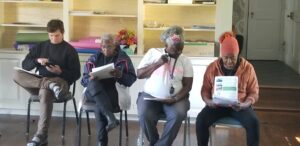Progress report for SNE22-006-MD
Project Information
Historically, the Delmarva (Delaware-Maryland-Virginia) Peninsula was a major hub for strawberry and raspberry production. However, current commercial production is negligible on the Eastern Shore (Somerset-Wicomico-Worcester) of MD. Similar situations exist in Delaware and Virginia. The cultivation of June bearing (JB) strawberries using the traditional matted row system is the only source of farm income during the spring season and thereafter most of the produce is imported from distant states. Similarly, growers in these areas are heavily depended on floricane fruiting type raspberries (FFTR) that too on small acreage. The cultivation of FFTR requires two year for fruit production and consume time and resources for pruning and disease management. In fact, cultivation of both the berries is negligible on the Eastern Shore with no information available on raspberry acreage in 2017 USDA Census of Agriculture. Most of the local growers have no idea about the existence of day neutral strawberries (DNS) and primocane-fruiting type raspberry (PFTR) varieties, which can extends the harvest season. This proposed extension outreach work will demonstrate sustainable approaches to extend the growing season using multiple JB and DNS under low and high tunnels and open bed regimes. Similarly, our sustainable approach to complement the existing FFTR cultivation system by PFTR under high tunnels regimes will accelerate the local berry production with more profit at farm. Our extensive extension plan (multiple hands-on training) will initiate the rejuvenation of strawberry and raspberry cultivation on the Eastern Shore of MD to benefit socially disadvantaged farmers, women farmers, small farmers, veteran farmers, and BIPOC (black indigenous and people of color) growers. The advisory board of this extension program is highly diverse, comprises extension agents, local growers, veteran farmers, BIPOC organizations, consumers, and faculty members to incorporate holistic education, and subsequently reaches to farmers from all the strata of the farming community.
10 Agriculture service providers who enrich their knowledge of season extension in strawberry and raspberry crops will teach 25 farmers about the use of June bearers and day-neutral strawberries and primocane raspberries for season extension in association with low and high tunnels. 10 Agricultural Service Providers will provide individual consultation and advice to 20 interested growers. 10 Agriculture service providers will further disseminate the work by the publication of factsheets and online study materials to 45 farmers and host workshops using the University of Maryland Eastern Shore (UMES) Small Fruit Plots for 45 farmers.
Description of Problem or Opportunity
Strawberries are economically important and a consumer favorite in the USA with a total production of 2.6 billion pounds (lb) in 2020 (USDA-NASS, 2021). In spite of increasing domestic demand, local production in several eastern states declined and almost nonexistent in local areas (Rom et al., 2014). Earlier (1919) USDA-NASS Census of Agriculture showed the existence of 5,260 strawberry farms and 7,000 acres with strawberry cultivation in Maryland (MD), which is now restricted to 146 farms and 210 acres (USDA-NASS, 2017). These data show a decline in strawberry acreage by 97% within a century. We are expecting further declines in strawberry production on the Delmarva Peninsula due to inclement weather throughout the growing season of JB and day neutral cultivars (DNC).
Currently, there is little production out of the main April-June period; therefore, season extension is essential for strawberry market and profit at farm. The strawberry industry in Mid-Atlantic is chiefly dominated by JB, short day cultivars, which restrict the peak production to spring or early summer seasons only, thereafter the primary supply is maintained by import from California (Mar.-Nov.) and Florida (Dec.-Feb.).
Similarly, raspberries (Rubus idaeus L.) are an economically important crop in the USA. Raspberries are also grown in the NE USA and Mid-Atlantics, but this production is not sufficient to fulfil the local demand. Raspberry production is negligible in the Tri-county area (Wicomico, Somerset, and Worcester) on the Eastern Shore of Maryland (USDA, NASS, 2017). There are only 4-small farms in Wicomico and Worcester County, which occupy a total area of less than 1 acre with raspberry cultivation (USDA, NASS, 2017).
Raspberry is a temperate crop, bears perennial roots, and short lived woody shoots called ‘canes’ (Sonsteby and Heide, 2008). These short-lived canes are of two types; biennial floricanes and annual primocanes. However, in floricane raspberries, the plants survive for two seasons and require labor-intensive pruning and protection from chilling temperatures (Pritts, 2008). Primocane-fruiting raspberries can extend the season from late summer into fall while floricanes harvest is restricted to six weeks during summer (Pritts, 2008). Moreover, annual removal of primocanes can limit the annual cycle of pests and pathogens, thus decrease expenses for fungicides and insecticides.
In 2020, under COVID-19 situation, I established an online coalition of growers and consumers with 181 active members throughout the Delmarva Peninsula to deliver online SARE workshops. An online request was communicated with coalition members to provide inputs on strawberry/raspberry cultivation challenges faced by them and to be the part of the advisory committee to develop the current extension outreach proposal. 15 farmers provided following challenges and knowledge gaps, which are incorporated in this proposal. In addition, our previous work on strawberry crop also showed some of these indigenous challenges. A: Source of strawberry and primocane raspberries, B: How to make raised beds? C: How to grow DNS? D: How to construct inexpensive low tunnels, E: Strawberry varieties suitable for Delmarva Peninsula, F: Technique for high tunnel production of strawberries and raspberries, G: Common pest and pathogen management.
Proposed Solution:
Even though strawberry industry is declining on the Delmarva Peninsula (USDA-NASS, 2017), there is no comprehensive extension outreach work was done on the production potential of multiple JB and DNC in open bed (OB) and high and low tunnel (HT/LT) regimes. A new system of strawberry cultivation, plasticulture system has showed improvement in yield and fruit quality compared to the matted row system (Fiola et al., 1995). Introduction of the HT system has been shown to advance the growing season of JB with early and high yield. HT protects the crop from low temperatures during the fall, early spring frosts, and as a consequence generates more revenue at the farm level (Rowley, 2010). We will demonstrate season advancement using the JB and HT/LT combination. To further extend the strawberry season beyond summer, we will demonstrate the cultivation of suitable DNC, which are insensitive to day length and have multiple harvests throughout the season (Lewers et al., 2017). We will demonstrate that the cultivation of JB and DNS in HT and LT regimes will extend the strawberry season by 10 months (March to Dec.) for local markets.
Weather conditions are ideal for raspberry cultivation in our area, dominated by cool days and sufficient sun light during summer and autumn. These conditions can extend the harvest season from early June to late December. The primocane-fruiting raspberries bear fruit in late summer and fall and later in winter, canes can be removed at ground level to allow new crop in spring. Primocane-fruiting raspberries can extend the season from late summer into fall while floricanes harvest is restricted to six weeks during summer (Pritts, 2008). Moreover, annual removal of primocanes can limit the annual cycle of pests and pathogens, thus decrease expenses for fungicides and insecticides. Cultivation of PFTR is a potentially profitable enterprise for small farmers on the Delmarva Peninsula. Moreover, use of HT cultivation of primocane will also improve fruit quality and season extension during fall months.
Service Provider Interest:
Agriculture service providers in this proposal comprises of county extension agent (2), urban agriculture agent (1), administrators and members of BIPOC farmer organization (2), veteran agriculture instructors (1), multi-disciplinary faculty members (4), socially disadvantaged growers (45), veteran growers (16), and 181 members of online coalition of growers and consumers on the Delmarva Peninsula. We are expecting to develop a ‘Small Fruit Team’ (8 or 10 trained extension personnel) and trained farmers (45) during the three years of this project. So far, only 2 extension agents (Urban Agriculture/Veteran agriculture instructor) committed participation in this program. They will attend the workshops and help in extension outreach. Other Ag. extension agent on the Delmarva Peninsula will also be communicated to participate in this program. However, 10 farmers showed willingness to help other farmers after getting hand-on training through this program.
Educational Approach
Engagement:
Project PI, Ag. service providers, and recruited local growers on the Delmarva Peninsula will communicate with other interested farmers to participate in this project over a period of 3-year. Each year educational materiel on previous workshops will be provided to new growers to keep them up to date on subject matter. Ag. service providers and farmers will use UMES small fruit plots for extension outreach events. In addition, UMES extension website will be provided to Ag. Service providers to communicate online or though the publication of factsheets. Educational PowerPoint will be shared with the Ag. Service providers to use during their independent workshops and one to one consultations.
Surveys of service providers will be conducted each year in October and information will be collected on their extension outreach activities related to this project. Collected information will be used to verify teaching actions and further suggestions/development/modification will be incorporated in the extension plan in the successive years.
Learning:
Each year four-extension events will be organized during October (June Bearers strawberry sowing), April (Day Neutral Strawberry and Floricane and Primocane Raspberry sowing), June (June Bearers strawberry and Floricane raspberry harvest), and September (Day neutral and primocane raspberry harvest) of each year at UMES. In addition to above mentioned four workshops, two more workshops will also be conducted for US service veterans in Baltimore in association with NGO, TALMAR. Ag. service providers in association with project PI will participate in teaching and demonstration classes during these workshops.
Educational approaches at each event will include a classroom presentation followed by the small fruit plot visit. All the practical trainings will be conducted at UMES experimental small fruit plots (low tunnels, high tunnels, and open bed) to observe the various phenology of fruit growth and development. Online classes will also be conducted using the Zoom platform. YouTube video will be created for field demonstrations and classroom teaching and link will be displayed on the UMES extension website and social media platforms (UMES- Horticulture Physiology Facebook Page; 200 growers are the current members on this page) to reach multiple stakeholders. In addition, visits to small fruit team members farms will be facilitated to promote farmer-to farmer leaning. Printed and online material will be provided to attendees after each workshop and through email communication.
We expect our program will enrich the following knowledge base of extension service providers and participating farmers to establish small-scale strawberry and raspberry cultivation plots to diversify fruit production on the small farms.
I: Understanding of DNS and PFTR phenology.
II: Selection of JB, DNS, FFTR and PFTR varieties suitable for the Delmarva Peninsula.
III: Raised bed preparation and use of raised bed machine.
IV: Construction of low tunnels and microenvironment within the high tunnels.
IV: Trellis design for raspberry cultivation within high tunnels and open bed regimes.
V: Fertigation, irrigation, and pest management.
VI: Harvesting stages and marketing approaches.
VII: Popular recipes and value added products from strawberry and raspberry fruits.
VIII: Developing enterprise budget and record keeping.
IX: Information will be provided on USDA/NRCS grants for HT purchase. Local sources of construction material for HT/LT will also provided to growers.
An overview of each year’s outcome will be provided to the new Ag. service providers. In addition, team members can also facilitate farmer’s visits to UMES small fruit plots (low and high tunnel) for education and learning purposes. Team members can also provide online study material to stakeholders or interested parties.
Evaluation:
Following information will be collected from Ag. Service providers and stakeholders.
I: How many farmers/growers attended small fruit workshops, field demonstration, on farm trainings you conducted during the past year?
II: How many farmers showed interest to adapt low tunnel, high tunnel, and day neutral strawberry cultivation technology for the season extension?
III: How many farmers showed interest to adapt high tunnel and primocane raspberry cultivation technology for the season extension?
IV: How many farmers order bare root strawberry plants?
V: How many farmers install high and low tunnels?
VI: How many farmers purchased primocane raspberry plants?
VII: What questions were raised by the farmers during teaching and advising?
IV: What suggestions and recommendations were provided by the farmers?
V: What kind of limitations and obstacles were faced by the farmers?
VI: What they did to teach and advise farmers?
VII: How many email, telephone calls, and face-to face advice was given to interested growers?
VIII: Post workshop evaluation will conducted to test the gain in knowledge, objective achievements, and suggestions to incorporate in the future workshops.
Milestones
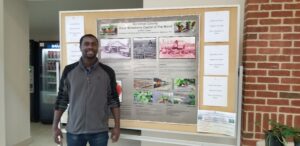
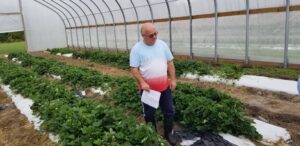
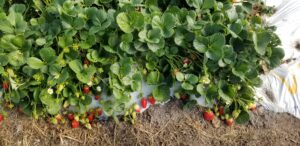
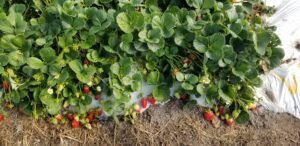
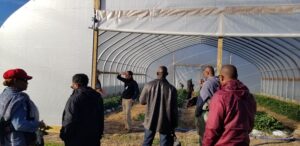
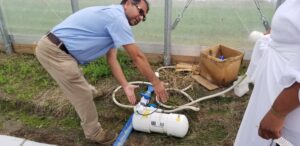
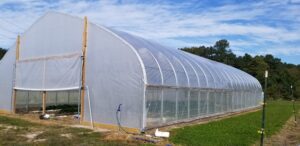
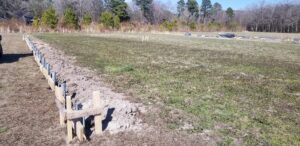
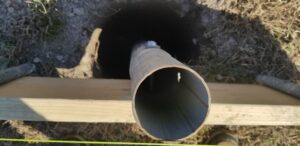
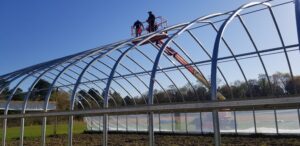
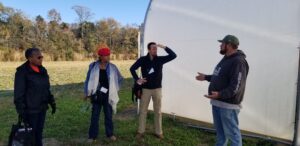
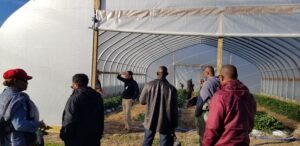
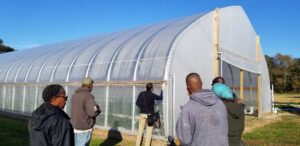
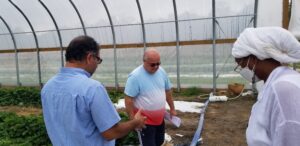
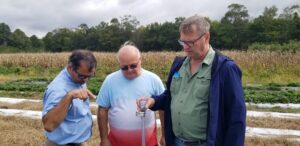
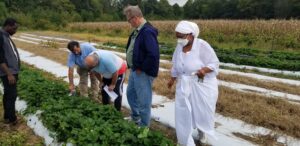
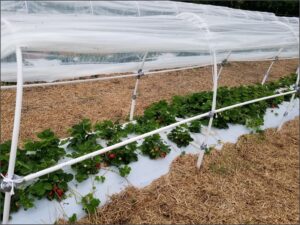
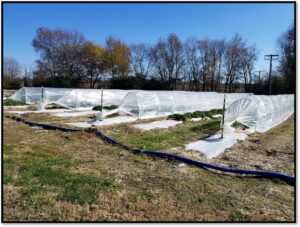
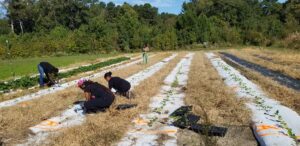
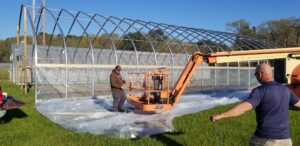
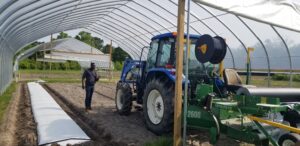
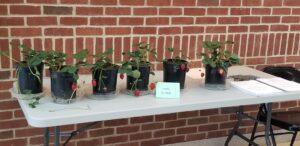
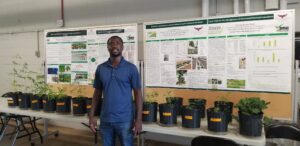
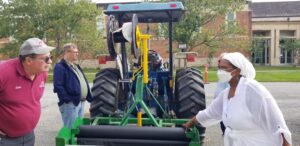
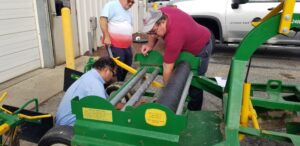
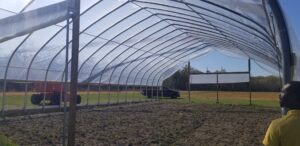
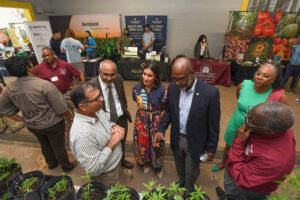
"This program will educate 8 or 10 agriculture service providers and 45 farmers over a period of three years.”
Milestone #1: (October-2022)
2 Agriculture service providers and 5 farmers will be communicated and invited to UMES small fruit plots to discuss the implementation of the proposed proposal. Participants will learn how to use raised bed machines and the phenology of June bearer (JB) strawberries. Information on suitable JB varieties will also be provided to the Ag. service providers and stakeholders. Participants will also be informed and trained for SARE Farmer Grant. Ag. Service providers and recruited farmers will provide this information to other interested farmers.
Milestone 1:
Status: Complete
Date of Complete: 10/7/2023
Accomplishment:
Number of Service Provider: 12
Number of Farmer: 49
Summary:
During the 19th Small Farm Conference (11/4/2022-11/5/2022), 5 Ag. Service Providers and 23 Farmers were recruited for the three-year NE SARE PDP Training Project on Strawberry and Raspberry Season Extension at UMES. Two additional high tunnels were created for training and demonstration purposes to make this notion a reality. To accomplish Milestone-1, four workshops were held: two workshops were held at Therapeutic Alternatives of Maryland (TELMAR), Baltimore, MD, from 5/3/2023 to 5/4/2023. The other two workshops were held at UMES on October 7, 2023. In addition. The outcomes of the seminars were discussed with Ag. Service Providers during the American Society of Horticultural Science (ASHS) Annual Meeting in Orlando, Florida (8/1/2023). Strawberry cultivation, a vital component of horticulture, requires a comprehensive understanding of modern techniques to optimize yields. This workshop provided information to Ag. Service Providers and farmers on how use of raised bed machines, the characteristics of June-bearer strawberry varieties, and the selection of appropriate mulch for raised beds. Workshop focused on the following aspects. Machine Operation: Provided hands-on training on how to operate raised bed machines, emphasizing key features and adjustments for different soil types. Maintenance Techniques: Educated farmers on routine maintenance tasks to ensure the longevity and efficiency of the raised bed machines. This includes blade sharpening, belt adjustments, and lubrication. Optimal Bed Dimensions: Discussed the ideal dimensions for raised beds, considering factors like row spacing, bed height, and overall layout. Explained how these dimensions contribute to effective water drainage and soil warming. Soil Preparation: Guided farmers on proper soil preparation before using raised bed machines, including soil testing, amendment incorporation, and leveling. Workshop and education material also provided information on Mulch Selection: Discussed various mulching materials such as straw, plastic, or landscape fabric. Evaluated the pros and cons of each, considering factors like cost, insulation properties, and environmental impact. Application Methods: Provided guidance on proper mulch application techniques, emphasizing uniform coverage and thickness to maximize benefits. Mulch Maintenance: Educated farmers on routine mulch maintenance, including weed control, replenishment, and removal at the end of the growing season. Impact on Soil Temperature: Explained how different mulching materials can influence soil temperature, affecting strawberry growth and development. This information will aid farmers in choosing the most suitable mulch for their specific climate and soil conditions. Information was also provided on Strawberry Varieties for season extension using early, mid, and late June-Bearer: Understanding the differences between June-bearer strawberry varieties is crucial for farmers to make informed decisions based on their specific needs and growing conditions. Farmers learned June-bearer varieties produce a concentrated harvest over a shorter period, typically in late spring to early summer. Limited harvest window, requiring precise marketing and distribution planning. The impact of providing training on the use of raised bed machines, understanding June-bearer strawberry varieties, and selecting appropriate mulch for raised beds is evident in the verified changes observed in participants' knowledge, attitudes, skills, and actions. 1. Increased Knowledge: Participants indicated a considerable gain in their understanding of the complexities involved in operating raised bed machines. This included a thorough understanding of appropriate bed dimensions and soil preparation processes. Farmers enhanced their awareness of the distinguishing characteristics of June-bearer strawberry types, allowing them to make informed judgments based on their individual agricultural aims and local conditions. Mulching (Black and White type) workshops aided in the advancement of knowledge about various materials, application methods, and the impact on soil temperature regulation. 2. Attitude Shift: Participants expressed greater confidence in adopting raised bed machines, recognizing them as valuable tools for optimizing strawberry yields. The nuanced understanding of strawberry varieties fostered a more adaptable mindset, allowing farmers to embrace diverse cultivation strategies based on market demands and seasonal considerations. Attitudes towards mulching (white for day neutral and Black for June Bearers) also shifted, with participants acknowledging its importance in weed suppression, moisture retention, and overall plant health. 3. Skill Development: Hands-on training sessions provided participants with practical knowledge on how to operate and maintain raised bed machines. Farmers improved their ability to build beds, modify machine settings, and troubleshoot typical problems. Participants learned the significance of white and black type of mulches and their use for specific crops. They also learned how temperate controls flowering in strawberries and concept of day length. 4. Awareness and Action: The training workshops raised participants' knowledge of the interconnectivity of their growing method choices and the larger agricultural ecosystem. 2 farmers will plant combination of day neutral and June Bearer strawberries next season (2024) using bed raised machine to actively shift from conventional to raised bed farming practices. 1 farmer is planning to adapt U-Pick system of marketing for raised bed strawberry cultivation. All the participants improved their mulching skills for strawberry cultivation and will use black type of plastic mulch for June Bearer strawberry cultivation.
Milestone #2: (April-2023)
4 Agriculture service providers and 8 farmers will be invited in the spring of 2023 at UMES small fruit plots to learn the phenology of day neutral strawberries (DNS) and floricane fruiting type (FFT) and primocane fruiting type (PFT) raspberries. Information on suitable varieties of DNS, FFT, and PFT will also be provided to the Ag. service providers. Participants will also learn about the source of local availability of these plants.
Milestone 2:
Status: Complete
Date of Complete: 5/4/2023
Accomplishment:
Number of Service Provider: 6
Number of Farmer: 31
Summary:
To accomplish Milestone-2, three workshops were conducted during May-November, 2023. Two workshops were conducted at Therapeutic Alternatives of Maryland (TELMAR), Baltimore, MD, from 5/3/2023 to 5/4/2023 for the socially disadvantaged beginning veteran farmers and 1 demonstration at UMES during the 20th Small Farm Conference (11/2/2023). 5 Ag. Service Providers and 15 farmers were also recruited for the 2024 NE SARE PDP Training Project on Strawberry and Raspberry Season Extension at UMES. Following information was provided on overview of day-neutral strawberries, emphasizing its distinct feature of continuous fruiting throughout the growing season. Advantages of Season Extension: Discussed the benefits of day-neutral strawberry production, focusing on how it helps farmers to lengthen harvest seasons and meet market demands over a longer period of time. Planting Demonstration: Given a live demonstration of planting day-neutral strawberries, demonstrated optimum procedures for bed preparation, planting depth, and spacing. Hands-on activities relevant to managing day-neutral strawberry plants, such as pruning procedures, pest management, and irrigation strategies, were demonstrated. Variety selection was described in detail for flavor, yield, and disease resistance. Information was provided on bareroot and plug plants and described about their benefits, planting methods, and suitability to certain growth environments. Discussed day-neutral strawberry soil requirements, sunshine exposure, and water management options. Provided fertilization suggestions for day-neutral strawberries at various growth stages. Participants were educated on the most common foliar diseases affecting day-neutral strawberries, as well as how to detect and control them early. Explained the relevance of eliminating early blossoms in order to divert energy toward plant establishment and fruit growth. Highlighted the yield potential of day-neutral strawberries as well as their great taste, stressing their consumer appeal. Provided insights into creating a UPick system, drawing clients to the farm for a one-of-a-kind and hands-on harvesting experience. Discussed effective customer engagement tactics such as farm tours, social media advertising, and community events. These workshops seek to equip farmers with the knowledge and skills required for successful day-neutral strawberry farming, season extension, and effective marketing by combining instructive sessions, hands-on exercises, and interactive demonstrations. Day-neutral strawberry cultivation, mulching for raised beds, irrigation and fertilizer management, liquid fertilizer application, the role of fertilizer injectors, marketing options, and agritourism have all had a significant impact, as evidenced by verified changes in participants' knowledge, attitudes, skills, awareness, and subsequent actions. 1. Increased Knowledge: Participants indicated a significant increase in knowledge about the benefits of day-neutral strawberries for season extension as season can be extended up to 9 months. Understanding the best mulching techniques (White type to regulate temperature during summer months) for raised beds, irrigation tactics (use of irrometer for irrigation scheduling) for the efficient use of water. The role of liquid fertilizers and the efficient use of fertilizer injectors for accurate nutrient administration. 2 farmers will use irrometer and fertilizer injector next season for the efficient management of water and fertilizer for sustainable strawberry cultivation. 2. Attitude Shift: A positive shift in attitudes towards adopting sustainable and season-extending practices was observed. Participants embraced the potential of day-neutral strawberries as a means of diversifying their crop calendars, leading to increased income at farm. Attitudes towards mulching (white outside and black inside) evolved, with participants recognizing its role in weed suppression, moisture retention, and soil health improvement. 3. Skill Development: Hands-on sessions improved practical abilities in day-neutral strawberry farming, including as planting, maintenance, and pest control. Participants mastered the application of liquid fertilizers with injector devices, maximizing nutrient delivery. Practical irrigation instruction on how to use irrometer prepared them to handle water efficiently in a variety of growing environments. 15 participants looking for a inexpensive type of fertilizer injector. 4. Awareness and Action: Participants are planning to diversify marketing tactics and agritourism potential such as farm tours and community engagement. This move reflected a greater knowledge of the relationship between sustainable agriculture practices and successful marketing efforts. 4 participants are planning for UPick system and youth education at farm. Adoption of these techniques not only demonstrated a commitment to sustainable agriculture, but also helped to the economic viability and resilience of farming communities. The positive changes seen highlight the importance of focused education in promoting agricultural practices and developing a more sustainable and economically viable farming community. Workshops on raspberries will be conducted next year as these plants are still growing and we are in the process of developing trellis system.
Milestone #3: (July-2023)
6 Agriculture service providers and 10 farmers will be invited in the summer of 2023 at UMES small fruit plots. Participants will learn how to construct inexpensive low tunnels (LT) to enhance the season extension of DNS. Participants will also learn how LT protects DNS from rainfall mediated fungal diseases. New team members who will join the project at later stages will receive previous educational materials to keep pace with the project. Local sources for LT materials will be provided to participants.
Milestone 3:
Status: Complete
Date of Complete: 9/29/2023
Accomplishment:
Number of Service Provider: 3
Number of Farmer: 13
Summary:
To accomplish Milestone-3, one workshop was conducted during September, 2023. Workshop conveyed step-by-step construction of low tunnels using PVC pipes, twine, and tape. Participants were explained the advantages of low tunnels in season extension, disease reduction, and improved fruit quality. Greenhouse films play a crucial role in controlling the growing environment within a low tunnel, influencing factors such as light transmission, heat retention, and durability. Participants were provided information on types of greenhouse films such as infrared films, anti-condensation films, diffused films, acrylic films, ethylene vinyl acetate films, polycarbonate films, polyvinyl chloride films, and polyethylene films for low tunnel construction. Shared success stories of farmers who have implemented low tunnels for disease management and higher yield of day neutral strawberries. Participants were also provided information on the budget of low tunnel construction. The educational programs centered on low tunnel construction utilizing low-cost materials such as PVC pipes, twine, tape, and various types of greenhouse films resulted in significant and validated changes in participants' knowledge, attitudes, skills, awareness, and actions. 1. Increased Knowledge: The participants demonstrated a significant increase in knowledge regarding the building and application of low tunnels. There was a shared knowledge of the basic principles at first, but as the sessions went, participants gained deeper insights into material selection, structural design, and the vital role of different types of greenhouse films. They got a thorough understanding of how UV-blocking and UV-transmitting films can effectively manage diseases and insects’ movement within a low tunnel and how light spectrum control help to extend the growing season and improve fruit quality. Specially success story of Mr. Mike from Virginia, who documented higher day neutral strawberry yield using low tunnels, encouraged participants to use low tunnels for strawberry cultivation. 1 socially disadvantaged women farmer and 1 beginning farmer are planning to use low tunnels for strawberry cultivation and other crops. 2. Attitude Shift: The workshop resulted in a positive shift in attitudes about the use of low tunnels as a viable and cost-effective alternative for improving strawberry cultivation. Participants initially questioned the simplicity of materials like PVC pipes, twine, and tape, but they gradually accepted these elements as accessible tools for producing efficient low tunnel structures. Participants recognized the economic benefits of adopting affordable materials without sacrificing efficacy as they became more aware of the possible benefits of various greenhouse films. 3. Skill Development: Participants developed actual skills that went beyond academic knowledge, such as learning to bend PVC pipes and precisely secure greenhouse films. Low tunnel construction became a concrete skill set, allowing participants to repeat the technique on their own farms. The acquired abilities extended beyond construction to include material selection, efficient assembly processes, and proper film installation, all of which contributed to the participants' confidence in properly implementing low tunnels. Participants documented how simple it is to build low tunnels. 4. Awareness and Action: 2 participants planning to put low tunnels up on their fields, displaying a proactive attitude to sustainable agriculture. The planned modification of light spectrums for season extension and the strategic use of UV-transmitting/blocking films for disease management demonstrated a greater grasp of the subtle elements impacting successful strawberry cultivation.
Milestone #4: (October-2023)
8 Agriculture service providers and 12 farmers will be invited in the fall of 2023 at UMES small fruit plots. Feedback will be collected from the participants to further improve the extension outreach program. Participants will learn about the management/purchase/parts/operation of high tunnels (HT) and associated problems. Participants will also be informed about the NRCS grant for HT. Participants will also be informed and trained for SARE Farmer Grant. Participants will also be informed about the local sources of HT construction material. Members of team (8 or 10) and farmers who patriciate in the earlier workshops responds to annual verification to report on teaching and assistance about strawberry and raspberry cultivation.
Milestone 4:
Status: Complete
Date of Complete: 11/02/2023
Accomplishment:
Number of Service Provider: 5
Number of Farmer: 15
Summary:
High tunnels (HT) have become invaluable assets for farmers, providing controlled settings that boost crop output and protect against inclement weather. Comprehensive information is essential for arming farmers with the knowledge and resources required for successful high tunnel use. Management, buying considerations, maintenance, operation, and the possible NRCS grant for high tunnels are among the topics covered in workshops and programs. Participants were instructed on the day-to-day operation of high tunnels, with an emphasis on the following essential areas: Strawberry variety selection for high tunnel farming was provided, taking into account local climate conditions, soil quality, and market demand. Participants learned how to regulate ventilation and temperature in order to produce an ideal microclimate for strawberries. Effective water management was emphasized, including drip irrigation and the importance of maintaining adequate moisture levels for strawberry. Participants were given advice on how to make educated selections when acquiring high tunnels. Advice on selecting the best materials, size, and design to meet specific farming needs and environmental conditions. Understanding the many ventilation options available and selecting systems that are compatible with the crops being grown. Comparisons of various covering materials, such as single or double layers of polyethylene, and their effects on light transmission, insulation, and durability. Participants were also educated on the value of endwall design in improving air circulation and structural integrity. Detailed information was provided on high tunnel parts and operation by Mr. Brian, Farm Crew Member, UMES; I: Step-by-step instructions for assembling high tunnel frames while maintaining structural integrity and stability. II: Demonstrations of proper covering material installation, including fastening, tightening, and sealing to enhance performance. III: Instruction on how to use roll-up side walls to effectively control temperature and humidity. IV: Endwall management techniques for optimizing airflow and preventing damage during harsh weather events. Participants were trained on frequent high tunnel farming issues and viable solutions. Information was also provided on strategies for preventing and managing diseases and pests in the high tunnel environment, methods for preventing fungal illnesses by resolving condensation difficulties and maintaining ideal humidity level, and training on frequent inspection and maintenance techniques to guarantee high tunnel lifetime and functionality.
The educational programs focused on the building, management, procurement considerations, parts, operation of high tunnels (HT), and addressing associated difficulties resulted in deep and verifiable improvements in participants' knowledge, attitudes, abilities, and behaviors. These courses not only provided participants with practical skills, but they also facilitated a paradigm shift in their approach to high tunnel agriculture. 1. Increased Knowledge: Participants indicated a significant increase in knowledge across multiple aspects of high tunnel farming. Participants gained an in-depth understanding of high tunnel construction, structural concerns, covering materials, and the complexities of optimal operation through workshops and hands-on activities. They gained a thorough awareness of issues such as disease management, pest control, and structural maintenance, allowing them to make informed decisions. 1 team member/participant got NRCS funded high tunnel for day neutral strawberry cultivation in the Wicomico County, MD. Based on recommendation of this program, two high yielding day neutral strawberry varieties (Seascape and Portola) will be cultivated in the next season (2024). 2. Attitude Shift: These workshops caused a beneficial transformation in participants' perceptions. Some participants may have initially seen high tunnel farming as complicated or out of reach. However, when they obtained hands-on experience and a greater grasp of the practical issues, their perception shifted noticeably. Participants began to regard high tunnels as not only practical but also necessary tools for optimizing strawberry yield, extending growing seasons, and managing weather hazards. Using high tunnels, we can demonstrate day neutral strawberry growing in Somerset County, MD until the third week of December. One female farmer will apply for NRCS-funded high tunnels in the next year. 3. Skill Development: Practical workshops were critical in participants' skill development. Participants developed skills in everything from building high tunnels and assembling their pieces to operating ventilation systems and addressing associated challenges. The information shared by the person who constructed these high tunnels at UMES created confidence that went beyond theoretical knowledge. Participants were not only educated, but also given the ability to implement what they learned in real-world high tunnel farming circumstances. Participants can order type of high tunnels they are interested in and similarly type of strawberry variety they want to grow for season extension. In fact, high tunnels can be the integral part of agritourism and can promote crop sale at the farm. Visitors can experience sustainable farming practices through high tunnels, which provide an immersive and educational component to agritourism. Exciting tours of these enclosed constructions provide insights into season extension, crop production, and technological integration. By demonstrating innovative and environmentally sensitive farming methods, high tunnels enhance the overall agritourism experience. 2 participants will allow UPick approach under high tunnels. 4. Awareness and Action: The workshop promoted a proactive approach, urging participants to include high tunnels into their overall farm management practices. In addition to strawberries, participants intend to cultivate other minor fruits and vegetables under high tunnels. One participant intends to use high tunnels to cultivate cut flowers and sweet potatoes. 5. Impact on Farming Practice: The verified changes in knowledge, attitudes, and skills have had a discernible impact on participants' farming practices. The implementation of high tunnels has resulted in extended growing seasons, improved crop yields, and enhanced resilience against adverse weather conditions. Participants reported a decline in disease incidences and improved pest management, indicative of the practical benefits derived from the workshops. 1 participant is embracing a dual approach, this participant plans to cultivate potted strawberries within high tunnels, offering not only luscious fruits but also thriving potted plants. By introducing this diverse product range at farmer markets, the participant aims to cater to both consumers seeking fresh, homegrown strawberries and those interested in cultivating their own berry-producing plants, creating a unique and appealing market proposition. 6. Adoption of Sustainable Practices: The workshops emphasized the need of sustainable and resource-efficient farming techniques in addition to technical considerations. Participants learned about soil health, water management, and organic pest control strategies. This broader perspective has contributed to a more environmentally responsible and sustainable approach to high tunnel agriculture. 2 socially disadvantaged participants shared their views to grow organic strawberries in high tunnels is a sustainable and environmentally friendly method. High tunnels produce a controlled environment that lowers the need for hazardous chemicals to control weeds and diseases. The enclosed building acts as a natural barrier against pests and reduces exposure to external toxins, making organic methods possible. This strategy is consistent with organic farming principles, encouraging soil health, biodiversity, and consumer well-being while providing a realistic answer for farmers committed to sustainable agriculture.
Milestone #5: (April-2024)
8 Agriculture service providers and 15 farmers will be invited in the spring of 2024 at UMES small fruit plots. Education will be provided on nutrition management in JB and DNS. Participants will learn about the use of fertilizer injector, fertilization calculations, and the benefits of liquid and granular fertilizers. Ag. service providers will produce factsheets and online educational material on above mentions aspects.
Milestone #6: (July-2024)
8 Agriculture service providers and 15 farmers will be invited in the summer of 2024 at UMES small fruit plots. Education will be provided on nutrition management in FFT and PFT raspberries. Participants will learn about the use of fertilizer injector, fertilization calculations, and liquid and granular fertilizers. Ag. service providers will produce factsheets/online educational material on above mentions aspects.
Milestone #7: (September-2024)
8 Agriculture service providers and 18 farmers will be invited in September 2024 at UMES small fruit plots. Participants will learn about the basics of irrigation and pest management in JB and DNS growing under HT, LT, and open bed regimes.
Milestone #8: (October-2024)
8 Agriculture service providers and 20 farmers will be invited in the fall of 2024 at UMES small fruit plots. Ag. service providers and farmers will learn about the fundamentals of irrigation and pest management in FFT and PFT raspberries growing under HT and open bed regimes. Feedbacks will be collected from growers and Ag. Service providers. Members of the team (8 or 10) and farmers who participated in the earlier workshops responded to annual verification to report on teaching and assistance about strawberry and raspberry cultivation. New participants will be informed about the NRCS grant for HT. New participants will also be informed and trained for SARE Farmer Grant.
Milestone #9: (April-2025)
8 Agriculture service providers and 25 farmers will be invited in the spring of 2025 at UMES small fruit plots. Ag. service providers and farmers will learn about the trellis construction for FFT and PFT raspberries cultivation. Ag. service providers will produce factsheets/online educational material on above mentions aspects.
Milestone #10: (July-2025)
8 Agriculture service providers and 28 farmers will be invited in the summer of 2025 at UMES small fruit plots. Ag. service providers and farmers will learn about the fruit maturity and harvest stage of strawberries/raspberries using refractometer and pH meter. Participants will also learn budget preparation and market strategies for the sale of strawberries and raspberries.
Milestone #11: (September-2025)
8 Agriculture service providers and 30 farmers will be invited in September 2025 at UMES small fruit plots. Participants will learn from Family consumer science faculty and local consumers how to make value added products from strawberries and raspberries for local markets.
Milestone #12: (October-2025)
Small Fruit Team members and growers will be invited in fall of 2025 at UMES. Members of the team (8 or 10) and farmers who participated in the earlier workshops responded to annual verification to report on teaching and assistance about strawberry and raspberry cultivation. Members will be asked to participate and provide inputs to develop a new SARE PDP proposal. New participants and stakeholders will also be informed and trained for SARE Farmer Grant.
Milestone Activities and Participation Summary
Participation Summary:
Learning Outcomes
Performance Target Outcomes
Performance Target Outcomes - Service Providers
Target #1
Agricultural service providers will undertake a multifaceted educational approach to disseminate knowledge about the season extension of strawberries using high and low tunnels, the cultivation of day-neutral and June-bearer strawberries, and the construction of high tunnels. The educational actions include. Organizing workshops to educate farmers on the benefits of season extension through high and low tunnels. Facilitating strawberry demonstration plots within high tunnels to showcase best practices in cultivation at UMES. Disseminating educational materials generated by the Principal Investigator, such as guides, manuals, and research findings. Actively promoting upcoming workshops on strawberry cultivation, season extension, and high tunnel construction. Utilizing various channels, including social media, agricultural publications, and local community announcements, to reach a broader audience. Developing printed materials for those with limited online access, ensuring inclusivity. Organizing field days for farmers to visit successful strawberry farms using high tunnels at UMES. Offering one-on-one consultations to farmers interested in adopting high tunnel cultivation or transitioning to day-neutral strawberry varieties. Providing ongoing support after workshops, including follow-up visits, to assess the implementation of learned practices. By adopting this comprehensive educational strategy, agricultural service providers aim to empower farmers with the knowledge and skills needed to successfully extend the strawberry season, implement high tunnel cultivation, and choose suitable strawberry varieties, ultimately contributing to the overall sustainability and profitability of their farming enterprises.
1/4th of an acre
| Year 1 | Year 2 | Year 3 |
|---|---|---|
| 6 |
1: Actively promoted upcoming workshops on strawberry cultivation at UMES
2: Utilized diverse communication channels, including social media and agricultural publications.
3: Encouraged farm visits to witness practical implementations at UMES.
4: Collaborations with other agricultural organizations for increased outreach.
5: Offered personalized consultations for farmers interested in high tunnel cultivation.
6: Facilitated networking opportunities for farmers.
7: Disseminating educational material and research findings generated by the Principal Investigator.
8: Encouraged farm visits to witness practical implementations at UMES.
9: Offered personalized consultations for farmers interested in high tunnel strawberry cultivation.
10: Provided information on NRCS funded high tunnels.
Through these focused actions, agricultural service providers aimed to equip farmers with the necessary knowledge and skills for successful strawberry cultivation, emphasizing season extension, high tunnel usage, and the cultivation of specific strawberry varieties.
| Year 1 | Year 2 | Year 3 |
|---|---|---|
| 32 |
| Year 1 | Year 2 | Year 3 |
|---|---|---|
5 Acre |
| Activity | Year 1 | Year 2 | Year 3 | Total |
|---|---|---|---|---|
| Curricula, factsheets and other educational tools | 1 | 1 | ||
| Consultations | 10 | 10 | ||
| On-farm demonstrations | 1 | 1 | ||
| Published press, articles, newsletters | 1 | 1 | ||
| Tours | 1 | 1 | ||
| Webinars, talks and presentations | 1 | 1 | ||
| Workshops and field days | 1 | 1 |
Twenty-six agricultural service providers were reached via email, text messages, and telephone calls. Of these, six service providers responded, providing valuable insights. Among the participating service providers, two farmers expressed intent to utilize high tunnels, aiming to extend the growing season, enhance yields, and decrease reliance on external factors. Additionally, four farmers expressed interest in diversifying their strawberry varieties, particularly by cultivating day-neutral strawberries, ensuring a consistent supply and expanding market opportunities. Furthermore, three farmers requested a demonstration of raised bed machinery for strawberry cultivation. Another three inquired about NRCS funding for high tunnels, indicating interest in financial support for implementing advanced agricultural practices. Four farmers expressed interest in visiting the UMES high tunnel strawberry trials to gain insights into season extension techniques. Notably, one agricultural service provider successfully facilitated a visit by 17 farmers to the UMES high tunnel site. This visit aimed to provide foundational knowledge on high tunnel construction and the utilization of day-neutral strawberries for season extension.
Performance Target Outcomes - Farmers
Target #1
34
Two farmers intend to plant a combination of day-neutral and June Bearer strawberries in the upcoming season (2024) using a bed raised machine, marking an active transition from conventional to raised bed farming practices. Another farmer is strategizing to adopt the U-Pick marketing system specifically for raised bed strawberry cultivation. Two farmers plan to incorporate irrometers and fertilizer injectors in the next season for efficient water and fertilizer management, promoting sustainability in strawberry cultivation. Fifteen participants are actively seeking an affordable type of fertilizer injector. Four participants are preparing for the U-Pick system and integrating youth education into their farm practices. One socially disadvantaged woman farmer and one beginning farmer are intending to employ low tunnels for strawberry cultivation and other crops. Two participants are proactively installing low tunnels in their fields, demonstrating a commitment to sustainable agriculture. One team member/participant successfully secured an NRCS-funded high tunnel for day-neutral strawberry cultivation in Wicomico County, MD. Another woman farmer plans to apply for NRCS-funded high tunnels in the coming year. Two participants are open to adopting the U-Pick approach under high tunnels. Additionally, one participant is adopting a dual approach, planning to cultivate potted strawberries within high tunnels, offering both delectable fruits and thriving potted plants. Lastly, two socially disadvantaged participants advocate for growing organic strawberries in high tunnels as a sustainable and environmentally friendly method.
6 Acre
34
Most of the change will be visible in the next cropping season of2024.
6 acre
A total of 108 farmers were contacted through email, text messages, and telephone calls, with 34 farmers actively responding and contributing valuable insights. These farmers are gearing up to cultivate a combination of day-neutral and June Bearer strawberries. Additionally, they are strategically planning to implement the U-Pick marketing system, particularly tailored for raised bed strawberry cultivation. There is a collective intention among farmers to introduce irrometers and fertilizer injectors in the upcoming season to enhance water and fertilizer management. Participants are currently in the process of actively exploring cost-effective options for fertilizer injectors. Furthermore, participants are diligently preparing for the U-Pick system, intertwining youth education into their agricultural practices. Farmers are considering the implementation of low tunnels for strawberry cultivation and other crops. Women farmers are expressing their aspirations to apply for NRCS-funded high tunnels in the upcoming year. Participants are receptive to adopting the U-Pick approach under high tunnels. Notably, farmers are embracing a multifaceted strategy, intending to cultivate potted strawberries within high tunnels, providing not only delicious fruits but also flourishing potted plants. Additionally, there is a collective advocacy for growing organic strawberries in high tunnels, recognizing it as a sustainable and environmentally friendly approach
SARE Outreach
My Sustainable Agriculture Research and Education (SARE) outreach program is multifaced and consist of multiple strategies including organization of following events.
1: Organization of NE-SARE Farmer Grant Writing Workshop.
NE-SARE Farmer Grant Writing Workshop #1. (9/30/2023). UMES, Princess Anne, MD (Number of participants: 5).
NE-SARE Farmer Grant Writing Workshop #2. (10/13/2023). UMES, Princess Anne, MD (Number of participants: 4).
2: Dissemination of NE SARE Printed material.
Distributing brochures, pamphlets, and other printed materials that highlight the goals, benefits, and success stories of the SARE program. These materials were distributed at agricultural events, workshops, and conferences.
Recieved information about SARE grant programs and information resouces:
| Audience | Year 1 | Year 2 | Year 3 | Total |
|---|---|---|---|---|
| Service providers | 26 | 0 | 0 | 26 |
| Farmers | 350 | 0 | 0 | 350 |
Information Products
- Strawberry and Raspberry Season Extension on the Delmarva Peninsula (Conference/Presentation Material)
